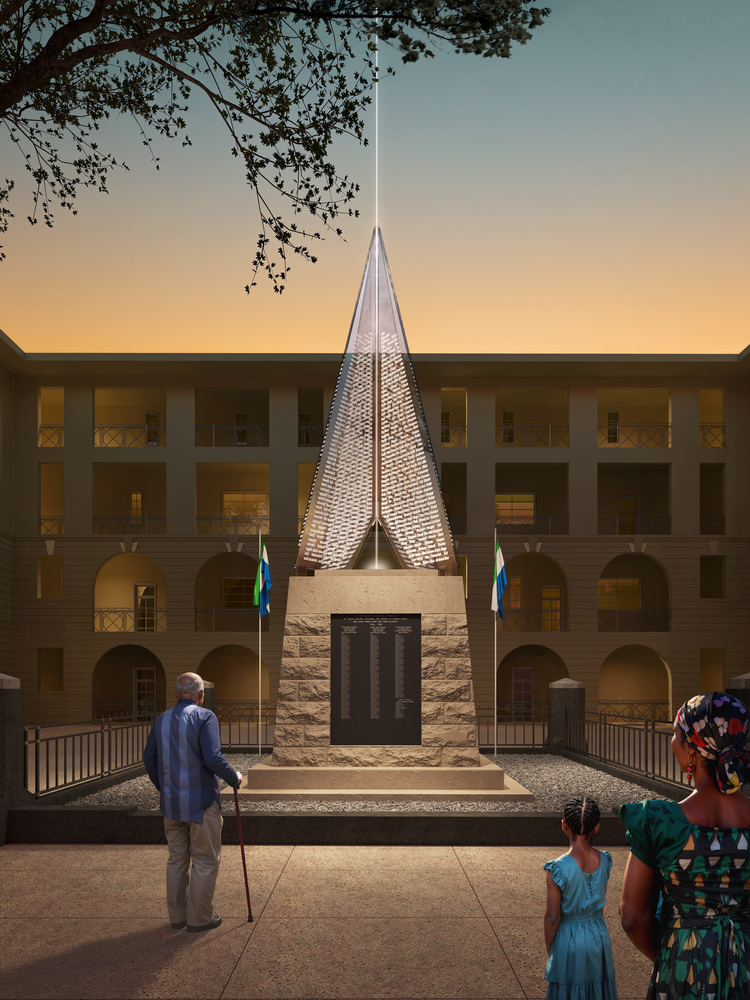
In Freetown, Sierra Leone’s capital, a new memorial is rising to honour the Sierra Leone Carrier Corps from World War I. These workers carried supplies through rough terrain, helping soldiers in the war. Many died, but their efforts were not recognized for almost 100 years. This new memorial stands as a testament to the recognition of those brave workers.
The Sierra Leone Carrier Corps played a vital role in World War I. They transported equipment and materials across areas where vehicles or animals can not go. Their work was dangerous, yet their sacrifices went unnoticed. The new memorial, commissioned by the Commonwealth War Graves Commission (CWGC), ensures their names and contributions are remembered.
Tosin Oshinowo, from Oshinowo Studio based in Lagos, Nigeria, designed the memorial, becoming the first woman and Nigerian architect to work with the CWGC. Standing 9 meters tall, her design rises prominently within a courtyard flanked by the government treasury buildings. Locally known as Sierra Leone’s National Memorial, the Freetown monument is being reimagined to achieve greater visibility—both symbolically and physically. The new design intends to make the memorial clearly seen by citizens and visitors from across the city, inviting public engagement and reflection. Access will extend beyond the original 7m × 7m boundary, creating a more inclusive and open space for remembrance.
Oshinowo’s design goes beyond the specifications to suggest a thoughtful and moving tribute appropriate for the area, returning ownership to the Sierra Leoneans. The structure features four large glass panels, each carved with the names of the 946 fallen Carrier Corps members. The glass panels are a key feature. During the day, they catch the sun, creating a sparkling effect. At night, a beacon on top lights them up, making them glow. This light can be seen from 5 kilometres away, a first for any CWGC memorial. The beacon shines on special days like Remembrance Day in November, symbolizing hope and memory.
The design works with an existing 1930 monument by Sir Edwin Lutyens. The glass structure rises above it, blending old and new. The glass is modern, unlike the stone of older memorials, and let’s light pass through. This creates a sense of openness and connection. The combination respects history while adding a fresh, contemporary look.
Creating the memorial took careful planning. Oshinowo’s team did extensive research with CWGC historians to learn about the Carrier Corps. They also worked with West African heritage experts and local communities. This ensured the design reflects Sierra Leone’s culture and history. The process uncovered a forgotten era, as few records or photos of the Carrier Corps exist. The memorial is designed to be approachable. People can walk up to it, unlike some memorials that feel distant. Its height and beacon make it visible across Freetown, connecting it to the city’s daily life. This accessibility gives Sierra Leoneans a sense of ownership over their history.

Honouring the past, shaping the future, our design for the Freetown memorial stands not only as a tribute to the fallen, those who lost their lives during the First World War, but as a symbol of Sierra Leoneans collective commemoration, representing cost of war and a people’s resilience, as well as the global commitment to peace for generations to come.”
_Architect Tosin Oshinowo
The project extends beyond Freetown. Four smaller memorials will be built in provinces where the Carrier Corps were recruited. These will mirror the main design, creating a network of remembrance across Sierra Leone. It will be a central place for events like Remembrance Day and other national celebrations.
This memorial does more than honouring the past; it teaches Sierra Leoneans about their history and the Carrier Corps’ role in the war. By using glass and light, it symbolizes transparency and hope. It also shows how modern African architects can create meaningful designs that respect local culture.
The Freetown Memorial is a powerful tribute to the Sierra Leone Carrier Corps. Its innovative use of glass and light makes it a standout piece of architecture. By blending with the past and engaging the community, it ensures the sacrifices of these heroes are remembered. Ultimately, it stands as a symbol of resilience and peace for Sierra Leone and beyond.
Discover more from dorted
Subscribe to get the latest posts sent to your email.






